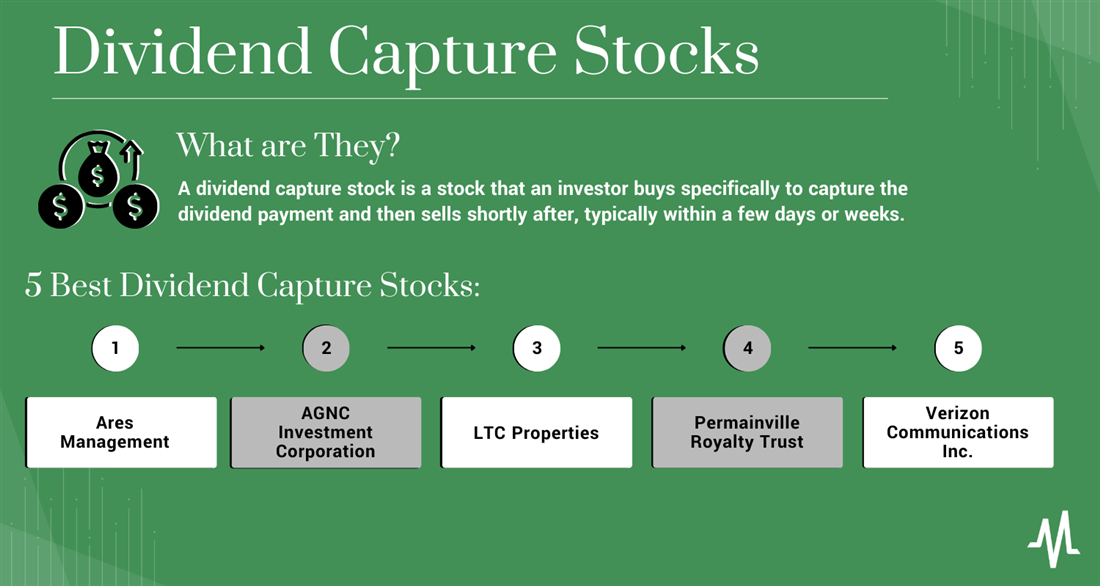
In the dynamic world of stock trading, the dividend capture strategy has emerged as a nuanced approach for investors seeking short-term gains while navigating the complexities of market dynamics.
This comprehensive guide delves into the essence of dividend capture, offering insights into strategies, risks, and the top dividend capture stocks to consider.
Understanding Dividend Capture: A Brief Overview
The dividend capture strategy revolves around a tactical approach — buying stocks shortly before dividend distributions and strategically selling them shortly after. The primary objective is to secure both the dividend payout and the capital gain from the subsequent sale as a profitable venture.

While this strategy offers the allure of short-term gains, it comes with inherent risks, particularly the potential for stock prices to drop post-dividend distributions. To navigate this terrain, investors need to carefully select stocks and employ effective risk management strategies.
Exploring Dividend Capture Stocks: A Gateway to Earning
Investing in dividend capture stocks presents an avenue for generating income by strategically capturing dividend payments and promptly selling the stocks. This approach is particularly appealing to income-oriented investors, such as retirees, aiming to supplement their earnings with periodic dividends.
The fundamental concept involves acquiring stocks a few days before the ex-dividend date, holding them long enough to receive the dividend, and then selling shortly after. This can also be applied to dividend exchange-traded funds (ETFs) that follow similar distribution methods as individual stocks.
While this strategy can yield dividend income, potential risks lie in the fluctuation of stock prices, especially in volatile markets. To mitigate these risks, investors may explore more intricate dividend capture strategies, such as using call options or dividend futures contracts.
The Art of Dividend Capture: A Strategic Approach
Successfully implementing the dividend capture strategy requires a systematic approach. Here’s a step-by-step guide to mastering the art:
1. Identify Dividend-Paying Stocks: Research and pinpoint stocks with upcoming dividend payments, considering factors like dividend history and revenue trends.
2. Note the Ex-Dividend Date: Focus on the ex-dividend date, the crucial day determining eligibility for the upcoming dividend. Be aware of both the ex-dividend date and the date of record.
3. Purchase and Hold: Acquire the stocks before the ex-dividend date and retain ownership until the dividend is paid out.
4. Collect Dividend Payment: After the dividend distribution, witness a cash payment in your account. Disable dividend reinvestment to retain cash.
5. Strategic Selling: Sell the stocks shortly after the ex-dividend date, potentially waiting for share values to recover if risk tolerance allows.
This strategic approach aims not only to capture dividends but also to navigate market dynamics, making it an attractive option for those seeking short-term cash flow.
Identifying Top Dividend Capture Stocks: A Sectoral Spotlight
Choosing the right stocks is crucial for successful dividend capture. Consider sectors known for stability and consistent dividend payments:
– Utilities: With consistent demand, utility stocks are favored for their predictability, albeit susceptible to regulatory changes.
– Real Estate: Real estate investment trusts (REITs), mandated to distribute a portion of revenue as dividends, offer predictable payment schedules.
– Healthcare: Steady demand across economic conditions and an aging population make healthcare stocks appealing, especially those with a history of dividend payments.
Risk Management Strategies: Navigating Potential Pitfalls
While the dividend capture strategy mitigates certain risks, prudent risk management is essential. Key considerations include market volatility, short-term focus, and the need for active management. Thorough research, limit orders, stop-loss orders, and diversification are integral components of effective risk management.
The Future of Dividend Capture: Pros and Cons
As with any investment strategy, the dividend capture approach comes with its set of advantages and disadvantages:
Pros:
– Income Generation: A potential source of short-term income through dividends.
– Capital Appreciation: Opportunity for capital appreciation, particularly if stock prices rise post-dividend.
– Diversification: Benefits portfolio diversification, especially when stocks span multiple sectors.
Cons:
– Market Volatility: Susceptibility to market volatility, leading to potential losses.
– Short-Term Focus: Geared towards short-term gains, may not align with long-term investment objectives.
– Active Management: Requires time-intensive research and active portfolio management.
Selecting the Best Dividend Capture Stocks: Spotlight on Top Performers
For those considering the dividend capture strategy, exploring top-performing dividend stocks is essential:
1. Ares Management Corp. (ARES): A global alternative investment management firm with a diverse portfolio, offering stability and large-cap operations.
2. AGNC Investment Corp. (AGNC): A real estate investment trust (REIT) focusing on agency mortgage-backed securities, showcasing a notable 15.24% dividend yield.
3. LTC Properties Inc. (LTC): Another REIT specializing in long-term care facilities, providing a monthly dividend with a 7.11% yield.
4. Verizon Communications Inc. (VZ): A multinational telecommunications giant known for its stable services, offering a 6.72% dividend yield.
5. Amplify High Income ETF (YYY): While not an individual stock, this ETF stands out for its higher-than-average dividend returns, maintaining a 12.3% average yield.
Pros and Cons of the Dividend Capture Strategy: A Balanced Perspective
Considering the potential benefits and drawbacks is crucial when adopting the dividend capture strategy:
Pros:
– Income Generation: Offers a source of short-term income for investors.
– Potential for Capital Appreciation: Opportunity for capital gains, especially if stock prices rise.
– Diversification: Can enhance portfolio diversification, spreading risk across sectors.
Cons:
– Market Volatility: Vulnerable to market fluctuations, potentially resulting in losses.
– Short-Term Focus: Geared towards short-term gains, may not align with long-term investment goals.
– Active Management: Requires dedicated time for research and active portfolio management.
The Road Ahead: Considerations and FAQs
Investors contemplating the dividend capture strategy should weigh the following considerations and frequently asked questions:
– Profitability: The profitability of dividend capture hinges on factors like transaction costs, market volatility, and post-dividend stock price movements.
– Top Dividend Yield Stocks: Dividend payments fluctuate, and as of January 2024, notable companies with high dividend yields include Brandywine Realty Trust, AGNC Investment Corporation, and Stellus Capital Investment.
– Wealth Generation: While investing in dividend-paying stocks can contribute to wealth generation, there are no guarantees, and regular portfolio reassessment is crucial.
Conclusion: Crafting Your Dividend Capture Journey
In conclusion, the dividend capture strategy provides a nuanced approach for those seeking short-term gains and income from the dynamic world of stock trading. Navigating this strategy requires a blend of strategic insight, risk management, and careful stock selection.
Whether you’re eyeing individual stocks or exploring the potential of ETFs, the dividend capture strategy offers a unique avenue to enhance your investment portfolio. As with any investment approach, careful consideration of risks, market conditions, and your own financial goals is paramount.
Embark on your dividend capture journey with prudence, armed with the knowledge of strategies, sectoral insights, and the top dividend capture stocks. The art of dividend